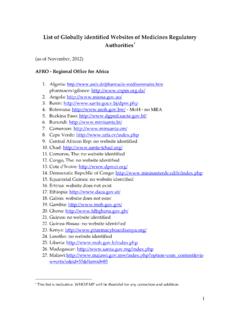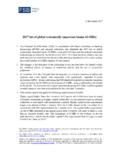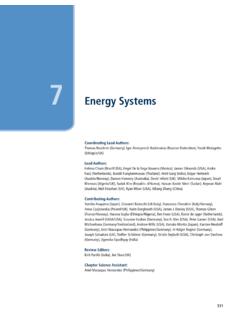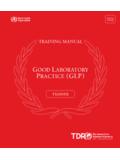Transcription of DomainKeys Identified Mail (DKIM) Service Overview
1 Hansen, et [1]Network Working GroupT. HansenRequest for Comments: 5585AT&T LaboratoriesCategory: InformationalD. CrockerBrandenburg InternetWorkingP. Hallam-BakerDefault Deny Security, 2009 DomainKeys Identified Mail (DKIM) Service OverviewStatus of this MemoThis memo provides information for the Internet community. It does not specify an Internet standard of anykind. Distribution of this memo is document provides an Overview of the DomainKeys Identified Mail (DKIM) Service and describeshow it can fit into a messaging Service . It also describes how DKIM relates to other IETF message signaturetechnologies. It is intended for those who are adopting, developing, or deploying DKIM. DKIM allowsan organization to take responsibility for transmitting a message, in a way that can be verified by arecipient.
2 The organization can be the author's, the originating sending site, an intermediary, or one of theiragents. A message can contain multiple signatures from the same or different organizations involved withthe message. DKIM defines a domain-level digital signature authentication framework for email, usingpublic-key cryptography, with the domain name Service as its key server technology (RFC 4871). Thispermits verification of a responsible organization, as well as the integrity of the message contents. DKIM also enables a mechanism that permits potential email signers to publish information about their emailsigning practices; this will permit email receivers to make additional assessments about messages. DKIM'sauthentication of email identity can assist in the global control of "spam" and "phishing".
3 RFC 5585 DKIM Service OverviewJune 2009 Hansen, et [2]Table of Contents1. Introduction .. DKIM's Scope .. Prior Work .. Internet Mail Background .. 52. The DKIM Value Proposition .. Identity Verification .. Enabling Trust Assessments .. Establishing Message Validity .. 73. DKIM Goals .. Functional Goals .. Operational Goals .. 94. DKIM Function .. Basic Signing .. Characteristics of a DKIM Signature .. The Selector Construct .. Verification .. Sub-Domain Assessment .. 125. Service Architecture .. Administration and Maintenance .. Signing.
4 Verifying .. Unverified or Unsigned Mail .. Assessing .. DKIM Processing within an ADMD .. 156. Considerations .. Security Considerations .. Acknowledgements .. 167. Informative References .. 17 Authors' Addresses .. 18A. Internet Mail Background .. Core Model .. Trust Boundaries .. 19 Intellectual Property and Copyright Statements .. 22 Index .. 23 RFC 5585 DKIM Service OverviewJune 2009 Hansen, et [3]1. IntroductionThis document provides a description of the architecture and functionality for DomainKeys IdentifiedMail (DKIM), that is, the core mechanism for signing and verifying messages. It is intended for thosewho are adopting, developing, or deploying DKIM.
5 It will also be helpful for those who are consideringextending DKIM, either into other areas of use or to support additional features. This Overview does notprovide information on threats to DKIM or email or details on the protocol specifics, which can be found in[RFC4686] and [RFC4871], respectively. Because the scope of this Overview is restricted to the technicaldetails of signing and verifying using DKIM, it does not explore operational issues, the details of servicesthat DKIM uses, or those that, in turn, use DKIM. Nor does it discuss services that build upon DKIM forenforcement of policies or assessments. The document assumes a background in basic email and networksecurity technology and allows an organization to take responsibility for a message in a way that can be verified by a organization can be a direct handler of the message, such as the author's, the originating sending site's, oran intermediary's along the transit path.
6 However, it can also be an indirect handler, such as an independentservice that is providing assistance to a direct handler. DKIM defines a domain-level digital signatureauthentication framework for email through the use of public-key cryptography and using the domain nameservice as its key server technology [RFC4871]. It permits verification of the signer of a message, as wellas the integrity of its contents. DKIM will also provide a mechanism that permits potential email signers topublish information about their email signing practices; this will permit email receivers to make additionalassessments of unsigned messages. DKIM's authentication of email identity can assist in the global controlof "spam" and "phishing".Neither this document nor DKIM attempts to provide solutions to the world's problems with spam, phishing,viruses, worms, joe jobs, etc.
7 DKIM provides one basic tool, in what needs to be a large arsenal, forimproving basic trust in the Internet mail Service . However, by itself, DKIM is not sufficient to that taskand this Overview does not pursue the issues of integrating DKIM into these larger efforts, beyond a simplereference within a system diagram. Rather, it is a basic introduction to the technology and its DKIM's ScopeA person or organization has an "identity" -- that is, a constellation of characteristics that distinguish themfrom any other identity. Associated with this abstraction can be a label used as a reference, or "identifier".This is the distinction between a thing and the name of the thing. DKIM uses a domain name as an identifier,to refer to the identity of a responsible person or organization.
8 In DKIM, this identifier is called the SigningDomain IDentifier (SDID) and is contained in the DKIM-Signature header fields "d=" tag. Note that thesame identity can have multiple DKIM signature can be created by a direct handler of a message, such as the message's author or byan intermediary. A signature also can be created by an independent Service that is providing assistance toa handler of the message. Whoever does the signing chooses the SDID to be used as the basis for laterassessments. Hence, the reputation associated with that domain name might be an additional basis forevaluating whether to trust the message for delivery. The owner of the SDID is declaring that they acceptresponsibility for the message and can thus be held accountable for is intended as a value-added feature for email.
9 Mail that is not signed by DKIM is handled in the sameway as it was before DKIM was defined. The message will be evaluated by established analysis and filteringtechniques. (A signing policy can provide additional information for that analysis and filtering.) Over time,RFC 5585 DKIM Service OverviewJune 2009 Hansen, et [4]widespread DKIM adoption could permit stricter handling of messages that are not signed. However, earlybenefits do not require this and probably do not warrant has a narrow scope. It is an enabling technology, intended for use in the larger context of determiningmessage legitimacy. This larger context is complex, so it is easy to assume that a component like DKIM,which actually provides only a limited Service , instead satisfies the broader set of itself, a DKIM signature: Does not authenticate or verify the contents of the message header or body, such as the author Fromfield, beyond certifying data integrity between the time of signing and the time of verifying.
10 Does not offer any assertions about the behaviors of the signer. Does not prescribe any specific actions for receivers to take upon successful signature verification. Does not provide protection after signature verification. Does not protect against re-sending (replay of) a message that already has a verified signature; therefore,a transit intermediary or a recipient can re-post the message -- that is, post it as a new message -- withthe original signature remaining verifiable, even though the new recipient(s) might be different fromthose who were originally specified by the Prior WorkHistorically, the IP Address of the system that directly sent the message -- that is, the previous email "hop"-- has been treated as an identity to use for making assessments. For example, see [RFC4408], [RFC4406],and [RFC4407] for some current uses of the sending system's IP Address.






